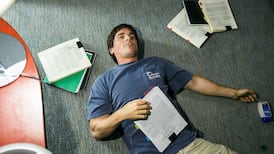In the post-Chernobyl climate of opposition to nuclear energy it is hard to believe that in the 1970s a proposal to build a nuclear power station at Carnsore Point, Co Wexford, was seriously considered. This was largely a result of the Middle East oil crisis of 1973/74 and the ensuing concerns in Ireland about the future of secure energy sources.
The Nuclear Energy Board, which was the forerunner of the Radiological Protection Institute of Ireland, was established in this period with statutory responsibility for commissioning and operating the nuclear station. One of its first recruits was Dr Noel Nowlan, who died on July 10th.
Noel Vincent Nowlan, the only child of Vincent Nowlan, a wine importer, and the artist Florence Conry, was born in Dublin in 1921. He was educated at Belvedere College and University College Dublin, where he was awarded a first-class honours degree in chemistry and the Hugh Ryan Medal in 1945. He completed his doctorate, also in chemistry, in 1949.
In the same year he married Alma FitzGerald, a fellow UCD scientist, and she and Noel moved to Liverpool where he initially worked with Lever Brothers Laboratories. In 1952 he joined the Royal Naval Scientific Service, where he developed a strong interest and expertise in corrosion chemistry and metallurgy, subjects which are particularly relevant to reactor safety.
His interest and experience in these fields led him to join the UK Nuclear Installations Inspectorate, which had recently been established in answer to calls for an independent regulator of nuclear activities following the fire in one of the Windscale reactors in 1957. Apart from a period of secondment to the Paris-based Nuclear Energy Agency of the OECD, where he worked on standardising regulatory frameworks for nuclear installations, he remained with the inspectorate until he returned to Ireland to join the Nuclear Energy Board in 1976.
After the stabilisation of the price and supply of oil, a lower than anticipated increase in electricity demand, and a growth in opposition to nuclear power after the accident at Three Mile Island in 1979, the plans to build a nuclear reactor in Ireland were shelved. This decision was followed by a period of uncertainty about the future role of the Nuclear Energy Board. However, Noel Nowlan had already realised the urgent need to regulate radiation sources used in medicine, industry, research and teaching. After he became chief executive in 1984, he developed a programme to ensure that all such sources were licensed and inspected by the board.
He also saw the a need for a comprehensive programme for monitoring radioactivity in the environment, although it took the Chernobyl accident to persuade politicians to make funds available for this purpose. He realised the importance of forging strong links with the universities - links which were to prove invaluable in terms of providing additional assistance in monitoring the effects on Ireland of the Chernobyl accident.
In addition, he considered it part of the board's remit to provide objective advice and information on nuclear matters, regardless of political implications. He was a strong supporter of the Joint European Torus (JET) research project on nuclear fusion, believing that fusion power would ultimately provide a source of energy without many of the hazards associated with the present-day, fission-based, nuclear industry.
Noel had a particular interest in naturally occurring radioactivity, especially radon gas, and was concerned that some people were being exposed to radiation doses significantly higher than those considered acceptable for workers in the nuclear industry. He considered it important to develop a national radon monitoring programme and to remedy houses and workplaces where high levels had been detected. He continued to exercise his interest in environmental monitoring after he retired and worked until very recently with Prof Peter Mitchell of University College Dublin on the dating of lake sediments by measuring their lead-210 content.
Noel's innate courtesy and consideration for others became quickly evident to everyone with whom he had contact. The relaxed professional relationship that he enjoyed with his staff belied the fact that he was between about 20 and 40 years older than most of them. Moreover, he was always happy to listen to the advice of his junior colleagues.
Many of his staff, including this writer, are especially grateful for the advice and encouragement he gave them in the early stages of their careers.
It was largely due to Noel's diplomacy that the medical profession, which was initially apprehensive about the introduction of any regulatory control over the uses of medical sources, welcomed such control in the interests of both patients and hospital staff. He also initiated the production of a code of practice to provide practical advice on the design of medical radiology facilities. This code is still is widely consulted by those involved in designing upgrading radiology facilities both in Ireland and abroad, particularly in developing countries.
Noel had many interests outside his work. These included anything to do with house-building and renovation, gardening, literature, music, travel and fishing. Much of his time in his final years was spent researching and writing his family history. He loved all things French, including good wine. He spoke the language well and, following his retirement in 1990, spent many happy times with Alma in his house in France.
He is survived by Alma and their five children, Hugh, Peter, Denis, Mary and Frances.
C.H.









